Seattle Travel Guide
The weather may not always be the best, but a holiday in Seattle is just as good indoors as out, with a host of activities on the menu all year round, from ballet to boating. This watery city points its landmark Space Needle at the stars, but is firmly anchored in its lakeland setting, which provides plenty of waterfront attractions to complement its trendy high-rise profile.
When in Seattle visitors should be sure to explore the foodie scene. The city is home to some fine restaurants offering wonderful sea views and cuisine both traditional and eclectic. For those who want to extend their evenings into the early mornings, there is some brilliant nightlife too.
Outdoorsy sophisticates with a taste for the good things in life will enjoy soaking up the atmosphere of this gleaming city on a holiday in Seattle.
Best time to visit Seattle
Visitors are just as likely to get their head wet as their feet, as not only is the city surrounded by water but plenty falls from the sky too. The driest months, and thus the best time to holiday in Seattle, are between June and August, when temperatures are also the most congenial. A trip to Seattle though, whatever the weather, is generally a much enjoyed one.
What to see in Seattle
-Admire the 'Hammering Man' that stands outside the Seattle Art Museum.
-Visit the historic district of Pioneer Square and explore more than 30 galleries.
-See the Seattle Space Needle, an internationally recognised symbol.
-View the many exhibits at the Museum of Pop Culture.
What to do in Seattle
-Catch a sightseeing ferry trip (or three!), a must when in Seattle.
-Sample local and organic treats at the Pike Place Farmer's Market.
-Take a trip to the Seattle Aquarium where adults and children alike can enjoy the extensive marine displays.
-See more than 130 aircraft at the Museum of Flight and learn all there is to know about aviation.
Beyond Seattle
Catch a ferry to one of the wonderful islands in scenic Puget Sound, the most popular being Bainbridge, which has its own winery and is only 10 miles (16km) west of Seattle. Another great way to spend a day is to venture to the northwest coast to enjoy the San Juan Islands and the Canadian Gulf islands, which form one of the best boater paradises in the world.
Getting there
Tacoma International Airport, more commonly known as Sea-Tac Airport, is just 12 miles (19km) south of Seattle and is one of the busiest in the US. This is where travellers land when visiting Seattle.
Did you know?
-Seattle is the most literate city in the US; home to the most bookstores and libraries per capita.
-Seattle has the second most glassblowing studios in the world, the place with the most being Murano, an island near Venice, Italy.
-Despite its reputation for being a rainy and wet city, Seattle actually receives less annual rainfall than both New York and Chicago.
Things to do in Seattle
Seattle's skyline, with the prominent Space Needle, is one of America's most recognisable cityscapes and hints at the eclectic attractions below. The attractions in Seattle both celebrate and preserve various roles in history, alternating from aviation and shipbuilding industries, the music epicentre and the Native American and contemporary art centre.
Other attractions let visitors enjoy the moment, including three sports stadiums, an aquarium, zoo, music laboratory and festive city districts. Sightseeing Seattle's watery attributes can be enjoyed criss-crossing Puget Sound in state ferries or from the lively waterfront shopping area Pikes Place Market.
Among the other highlights are the great museums showcasing the history of flight, contemporary art, an ode to rock n' roll at the Museum of Pop Culture, and of course, the views from the Space Needle. Yet perhaps the best thing to do is follow the locals in and around the city to see and enjoy Seattle the way they do.
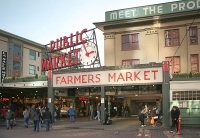
Pike Place Market
The busting Pike Place Farmers Market in downtown Seattle has provided the local people with producer-priced goods for decades. Today, more than 100 farmers and fishmongers continue the tradition, with a focus on local and organic food. They're joined by more than 150 local craftsmen and artists, along with street performers, dozens of restaurants and numerous speciality shops. Interestingly, the world's first Starbucks coffee shop opened here in 1971, and is still brewing up its famous beverage on the original site. At the north end of the market, Victor Steinbrueck Park provides a popular grassy place to lounge in the sun. Events are hosted at the market, such as the May Flower Fest Market and Sunset Supper at the Market.
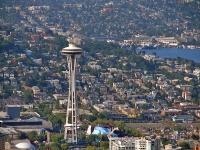
Seattle Space Needle
Anyone who has seen a picture of the Seattle skyline will be familiar with Seattle's internationally recognised symbol, the futuristic Space Needle. Visitors can get to the top of the historic landmark using one of the elevators that travel at ten miles an hour, reaching the observation deck within 43 seconds. Visitors can ascend the 607ft (185m) building as far as a revolving observation deck 520ft (158m) above the city, where high-powered telescopes are positioned to allow you to pick out the city sights. There is a revolving restaurant on top of the tower that allows visitors to take in every part of the panoramic views while enjoying a meal.
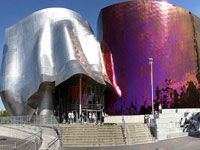
Museum of Pop Culture
Housed in a bizarre building at the base of the Space Needle is one of Seattle's most popular attractions, the Museum of Pop Culture. Its exhibit on Jimi Hendrix features artefacts associated with the rock legend, and remains the biggest drawcard at the museum. Other collections include the general history of American popular music, and another dedicated to Seattle's other famous musician, Kurt Cobain. Displays range from the first electric guitars to interactive rooms where visitors try their hands on turntables or playing instruments. A Science Fiction Hall of Fame honours the lives, works and ongoing legacies of some of the world's most influential science fiction writers, among them Ridley Scott, George Lucas and H.G. Wells. The museum is also the venue for numerous concerts.
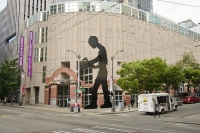
Seattle Art Museum
Jonathon Borofsky's massive steel kinetic sculpture Hammering Man stands outside the Seattle Art Museum, and what sits within are ranges of exhibits covering European and American art, from ancient art to contemporary pieces. Currently the museum has over 23,000 pieces, with recent acquisitions of artists such as Graves, Trabellesi and Hokusai. Free guided tours of the different collections are offered. The museum has a focus on collecting and exhibiting art from around the world, covering many cultures and time periods including Mesoamerican art and Aboriginal Art. The Asian Art Museum is affiliated to the original and is located at 1400 East Prospect Street, filled with Asian art from as far back as the 2nd century, while the Olympic Sculpture Park is a permanent outdoor exhibition of sculptures, including Eye Benches I, Father and Son and Schubert Sonata.
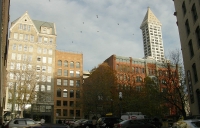
Pioneer Square
South of downtown, the district of Pioneer Square features more than 20 blocks of historic buildings, galleries and a great nightlife. The Klondike Gold Rush National Historical Park recalls the days when Seattle was a jumping off point for hopefuls heading for the goldfields. Another visitor favourite is the unique Underground Tour, taking in the sunken storefronts of the original 'Skid Road', where timber used to be slid down to the steam-powered mills on the shores of Elliott Bay. On the first Thursday of every month, all art galleries and museums remain open for the evening, serving snacks and drinks and allowing visitors to mingle and visit while looking at the artwork on display.
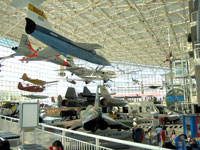
Museum of Flight
The Museum of Flight consists of a six-story glass and steel construction, which was the original Boeing factory and used to be one of the mainstays of Seattle's economy. It covers the entire history of flight right up to the space programme. Inside is a collection of more than 130 aircraft, including a replica of the Wright Brothers' first glider and the original Air Force One used by Eisenhower. Other acquisitions include a British Airways Concorde and NASA's Full Fuselage Trainer. Temporary exhibitions keep things interesting, while restoration work on various aircraft is constantly ongoing at the museum, with two to four new acquisitions every year and about twelve aircraft being worked on at any one time.
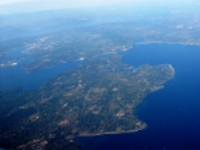
Puget Sound Islands
Ferries depart regularly from the Seattle piers, carrying passengers to the many islands in scenic Puget Sound. On the tip of the Kitsap Peninsula is the city of Bremerton, where travellers will find the Puget Sound Naval Shipyard Museum and the USS Turner Joy (one of 18 Forrest Sherman-class destroyers of the United States Navy), and Bainbridge Island, which has its own winery. Winslow is a small historic town with fine restaurants and a great view of Seattle, while Vashon Island is an artists colony. Further afield are the San Juan Islands, with their miles of unspoilt beaches and state parks. Travellers can go whale-watching, kayaking or cycling, or partake in a round of golf or a run on well-kept trails.
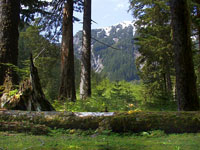
Olympic National Park
Outdoor enthusiasts revel in the wilds of the Pacific Coast, with its glacier-capped mountains, ancient forest and fascinating biological diversity. About 95 percent of the park is a designated reserve, protecting the unique ecosystem on the Olympic Peninsula. Visitors can go mountain biking, horse-riding canoeing and kayaking, as long as they bring their own kit. Fishing in the 3,000 miles (4828km) of rivers and streams is particularly popular, as is hiking. But the weather can be temperamental so travellers should dress accordingly. Also, it's unsafe to drink the water so bringing water is essential.
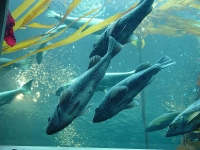
Seattle Aquarium
Located on the waterfront, the Seattle Aquarium provides a window into the amazing marine life of the Pacific. The Underwater Dome is one of the largest exhibits, providing 360 degree views of creatures such as sharks, sturgeons and skates, while Marine Mammals features cute seals and sea otters. Touch pools contain animals such as sea stars and urchins, while live dive shows take place three times a day. Other exhibits at the Seattle Aquarium are Life Of A Drifter, Puget Sound Fish and Tropical Pacific. The aquarium has a big focus on environmentalism, taking care to educate visitors about marine conservation, while also hosting events for kids and Halloween.
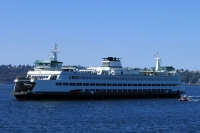
Washington State Ferries
A quintessential part of Seattle, ferrying is a culture and way of life to its residents, with many commuting to work across the Union Lake and Elliot Bay areas. If possible, visitors should try to plan sight-seeing of the city around several ferry trips going from point to point, allowing for maximum sightseeing. Trips to local attractions such as the San Juan Islands and Victoria in nearby Canada are on offer. Travellers should be sure to remember their passport and any other necessary and valid travel documents before embarking on a ferry ride to Victoria.
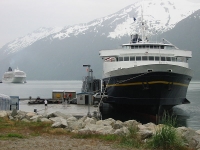
Alaskan Ferry
Large cruise ships regularly travel to major ports in Alaska, though a better, smaller option is the Alaskan Ferry. Departing from Bellingham Washington, these large ferries travel around the major coastal towns of Canada, the Gulf of Alaska, and the Alaskan Peninsula. The landscape is staggering, revealing hundreds of craggy forest-dense islands and coastlines. Eagles, killer whales, bears, and other wildlife are all part of the view. The months of operation are May to September, when the weather is bearable and sunshine illuminates most of the 'night' hours, making the days long so there is plenty of time to fit in lots of sight-seeing. Costs vary greatly on length of voyage and accommodation. Most ferries rent cabins, but those in tune with Alaska's pioneer spirit can pitch a tent on deck or just use a blanket. However, if travellers do choose to go with a cabin, there are some very comfortable options available. It's possible to plan an extensive tour of Washington's, Canada's, and Alaska's coast lines, stopping off at various points of interest along the way. Special fares are available throughout the year upon request.
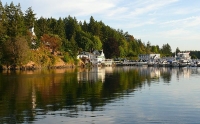
San Juan and the Gulf Islands
Located off the northwest coast of Washington, the San Juan Islands and the Gulf Islands are separated by nationality but form part of the same scenic archipelago. Much of the area is a surprisingly dry and sunny reprieve in the northwest, with little island communities, great wildlife and the open water providing a retreat from the mainland. Seemingly out of a Norman Rockwell painting, the islands contain many little farms and fisheries, and agri-tourism has become an important part of the island's tourist trade. The wine farms host guests in charming cottages overlooking vineyards, where they learn more about grape and wine cultivation. Friday Harbour is San Juan's largest town and an enchanting tourist destination.
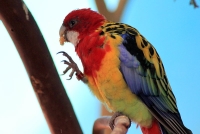
Woodland Park Zoo
Located in Green Lake, the Woodland Park Zoo is a great place to take the kids for a day out exploring and meeting the animals. Kids will love the African elephants, Arctic foxes, sloth bears and red pandas or snowy owls, Chilean flamingos and golden eagles. There's also a fantastic variety of invertebrates such as spiders and butterflies, with over 1,100 animals from more than 300 species included in the zoo's collection. The animals' enclosures are carefully landscaped to include all kinds of interesting exotic plant life, and there is also a rose garden for peaceful strolling.
Things to do with kids in Seattle
Kids will have a fabulous time exploring all the sights on offer, most of them being child-friendly and all-inclusive. Visitors can take a trip to the Seattle Aquarium, where children can learn and be mesmerised by the exquisite displays of fish and marine life, or head over to the Woodland Park Zoo to meet some furry friends.
More active children will love a day out at the Olympic National Park, where glacier-capped mountains meet lush green forest and they can stretch their legs and take in a hike, walk or even mountain bike. Children who are interested in aviation will love the Museum of Flight.
On days when the rain sets in and outdoor activities with the kids are not an option, visitors should head to the Children's Museum with the little ones, while older kids will love the Museum of Pop Culture, even if just for the zany design of the pink building.

Museum of Flight
The Museum of Flight consists of a six-story glass and steel construction, which was the original Boeing factory and used to be one of the mainstays of Seattle's economy. It covers the entire history of flight right up to the space programme. Inside is a collection of more than 130 aircraft, including a replica of the Wright Brothers' first glider and the original Air Force One used by Eisenhower. Other acquisitions include a British Airways Concorde and NASA's Full Fuselage Trainer. Temporary exhibitions keep things interesting, while restoration work on various aircraft is constantly ongoing at the museum, with two to four new acquisitions every year and about twelve aircraft being worked on at any one time.

Olympic National Park
Outdoor enthusiasts revel in the wilds of the Pacific Coast, with its glacier-capped mountains, ancient forest and fascinating biological diversity. About 95 percent of the park is a designated reserve, protecting the unique ecosystem on the Olympic Peninsula. Visitors can go mountain biking, horse-riding canoeing and kayaking, as long as they bring their own kit. Fishing in the 3,000 miles (4828km) of rivers and streams is particularly popular, as is hiking. But the weather can be temperamental so travellers should dress accordingly. Also, it's unsafe to drink the water so bringing water is essential.

Seattle Aquarium
Located on the waterfront, the Seattle Aquarium provides a window into the amazing marine life of the Pacific. The Underwater Dome is one of the largest exhibits, providing 360 degree views of creatures such as sharks, sturgeons and skates, while Marine Mammals features cute seals and sea otters. Touch pools contain animals such as sea stars and urchins, while live dive shows take place three times a day. Other exhibits at the Seattle Aquarium are Life Of A Drifter, Puget Sound Fish and Tropical Pacific. The aquarium has a big focus on environmentalism, taking care to educate visitors about marine conservation, while also hosting events for kids and Halloween.

Woodland Park Zoo
Located in Green Lake, the Woodland Park Zoo is a great place to take the kids for a day out exploring and meeting the animals. Kids will love the African elephants, Arctic foxes, sloth bears and red pandas or snowy owls, Chilean flamingos and golden eagles. There's also a fantastic variety of invertebrates such as spiders and butterflies, with over 1,100 animals from more than 300 species included in the zoo's collection. The animals' enclosures are carefully landscaped to include all kinds of interesting exotic plant life, and there is also a rose garden for peaceful strolling.
Eating Out
Dining in Seattle is much like the city itself, a cosmopolitan affair born from the fruits of the wilderness. The surrounding Puget Sound, with reserves from Alaska, is one large barrel of seafood, coupled with produce grown from many small local farms in Seattle, resulting in masterful and memorable dishes.
In addition to the traditional North-western cuisine such as wild salmon or Dungeness crab, there is a strong Asian influence borne out of the large Asian-American communities and Seattle's importance as a trade port on the Pacific Rim. This means that the food in Seattle is eclectic and caters to many tastes.
Restaurants are helped by great views of the sea and many quirky neighbourhoods, giving either quiet romance or fun and festivity to a meal. Some of the best areas for eating out in Seattle are the waterfront district near Pike's Place Market, a long line of fine dining along 1st and 2nd Ave and Capitol Hill. In general the Northwest's formality is a little toned down and most top restaurants don't require a jacket. Tipping is between 15 to 20 percent and most places require a reservation.
Shopping
Shopping in Seattle is underrated. Famed for grunge music and Seattle coffee companies, this city also has excellent retail outlets. The prime spots include Downtown Seattle, Fremont, the International District, Pike Place and the University District.
Downtown Seattle is a square of several blocks with large outlets such as Urban Outfitters, Nordstrom and Gap. This is also the site of Westlake Center Plaza and Pacific Place, both large malls. The International District encompasses a vast area featuring numerous Asian shops, while Pike Place Market is a waterfront shopping area offering local produce, fresh fish and various restaurants.
There are many bargains to be found at the retro and vintage stores of the Fremont Market on Sundays, and districts such as Fremont, Ballard, Capitol Hill, Wallingford, and West Seattle, all of which have independently owned shops and specialty stores to entice shoppers. Tax refunds can be applied for by foreign visitors.
Nightlife
Though the city made a name for itself on the international music scene with its grunge explosion in the early 1990s, some of Seattle's best nightlife and entertainment has nothing to do with music. Among the ubiquitous live music clubs there are scores of local bars, Irish bars, dive bars, posh lounges, clubs, and trendy eateries to enjoy. After catching a sunset at the waterfront, Bell Street Pier, or Myrtle Edwards Park, travellers can head to Pioneer Square where bars, live music, and nightclubs prevail. The Belltown is also a popular spot for young and hip nightclubs, while in Capitol Hill the gay scene is always buzzing. Culture vultures should check out the Seattle Opera, which is ranked at the top of companies in the country, while the renowned Seattle Symphony is also worth checking out. The Seattle Repertory Fringe Theatre is great for the more avant-garde productions.
Getting Around
Seattle city centre is well serviced by public transport, with an excellent bus system, historic streetcars along the waterfront, and a high-speed elevated Monorail that links downtown to the Seattle Center and offers views over the harbour and beyond. The bus system is the most extensive and runs throughout the night, but less frequently after 8pm. Fares on buses and trams are slightly more expensive during peak hours. Taxis can be hailed from taxi ranks or ordered by telephone; ride-hailing apps such as Lyft and Uber are also available. Parking in Seattle is expensive and limited, but traffic isn't too bad outside of rush hour and the city is fairly easy to navigate. Renting a car for excursions outside the city is a good option.
Seattle Climate and Weather
Seattle generally has a wet climate, with the most rain falling between January and May, and October and December, but daytime temperatures are mild throughout the year. June to August is the warmest and driest time of year, with summer temperatures averaging around 75F (24C), while winter temperatures rarely drop below 32F (0C), with little snowfall. April to November is the best time to visit, with less chance of rain and long summer days.
United States of America travel info
Electricity
The electrical current is 120 volts, 60Hz. Plugs are mainly the type with two flat pins, though three-pin plugs (two flat parallel pins and a rounded pin) are also widely used. European appliances without dual-voltage capabilities will require an adapter.
Language
English is the most common language spoken but Spanish is often heard in the south-western states.
Money
The official currency is the US Dollar (USD), which is divided into 100 cents. Only major banks exchange foreign currency. ATMs are widespread and credit cards are widely accepted; Apple Pay and Google Pay are very popular. Banking hours are Monday to Friday 9am to 3pm.
Tipping
A 15 percent tip is expected by taxi drivers, bartenders, hairdressers and waiters, but travellers shouldn't tip in fast-food or self-service restaurants. In expensive restaurants or for large parties, the tip should be 20 percent of the bill. It's normal to tip staff such as valets and porters in hotels; this is discretionary, although a minimum of $5 is expected. Most services are customarily tipped if the service is good.
Health
There are no specific health risks associated with travel within the USA. Medical facilities are excellent, but expensive. Only emergencies are treated without prior payment and treatment can be refused without evidence of insurance or proof of funds. Good medical insurance is essential.
Safety
Travel within the United States is generally trouble-free, though travellers should be aware that the US shares with the rest of the world an increased threat from terrorist incidents. Security has been heightened, particularly at airports. Restrictions on hand luggage apply and travellers are advised to check on the latest situation with airlines in advance. Travellers should also be alert to the dangers of car and street crime in cities and should use common sense and take basic precautions. Hurricanes are common between June and November, putting the southern USA, including the Gulf Coast and the eastern US at risk. There's a risk of wildfires in many dry areas in the US, particularly on the West Coast from March to November.
Local customs
Laws vary from state to state, including speed limit, fines and punishment. The age at which alcohol may be legally bought and consumed is 21 years.
Doing business
In such a large country, filled with so many diverse groups, business practices may differ according to each state, though rarely to any large degree. The East Coast is traditionally more formal than the West Coast, though in states such as California, dress code and conservative appearance are as common as they would be in New York. Punctuality is important throughout the country and it's considered rude to be late for a meeting. Gift-giving is uncommon as it may be construed as bribery. Appropriate titles (Mr, Mrs, Ms) are used upon introduction and until otherwise stated. Americans favour politeness and greetings of 'Hello' and 'How are you?' are often expressed with sincerity. Business hours may vary in each state, but an 8am start and 5pm finish Monday to Friday is the most common with an hour over lunch.
Status and age are not necessarily indicative of seniority, nor do they carry much weight in themselves. Those doing business in the States should be mindful of this fact; foreigners should never make assumptions about someone's position or rank. Best practice is to be respectful to all parties. That said, the US upholds a hierarchal business structure in which 'the boss' is the ultimate decision-maker. Senior leaders have the power of the last word, and can go against the grain just as easily as they can follow popular opinion. Foreigners should concentrate on winning over this individual, even if the greater group seems unsupportive. Americans value a direct style of communication. In this fast-paced, consumer culture 'time is money', and small-talk is viewed as unnecessary and wasteful. It's best for foreigners to get to the point quickly, speak about issues in a frank and open manner, and to avoid taking offence if someone questions or challenges them outright.
Duty free
Travellers to the United States who are returning residents of the country do not have to pay duty on articles purchased abroad to the value of $800 provided their stay was longer than 48 hours and their duty-free allowance was not used in the 30-day period prior. For passengers arriving from Samoa, Guam and the U.S. Virgin Islands, a duty-free allowance of $1,600 is allowed. The following items are included in this: 50 cigarettes and 10 cigars and 150 millilitres (5 fl. oz.) of alcoholic beverages or 150 millilitres (5 fl. oz.) of perfume containing alcohol. Restrictions may apply to goods from Cuba, Iran, North Korea, Burma (Myanmar), Angola, Liberia and Sudan. It is prohibited to import Cuban cigars from any country.
Travellers to the United States who are non-residents do not have to pay duty on the following items: 50 cigars or 200 cigarettes and gifts to the value of $100 provided their stay in the USA is not less than 72 hours and that the allowance has not been used in the preceding six-month period.
Prohibited items for residents and non-residents include meat or meat products, poultry, narcotics, absinthe, plants, seeds, vegetables, fruits, soil, live insects and other living plants or animal pests. Fish is prohibited unless it carries disease-free certification. Wildlife and animals or their by-products carry restrictions. Dairy products and eggs from specified countries are not allowed. Firearms and ammunition are not allowed without the necessary license and permit.
Communications
The international country dialling code for the United States is +1. Mobile networks cover most of the country, especially all urban areas; travellers can purchase local prepaid SIM cards for unlocked phones or use eSIMs if their cellular providers support it on their networks. WiFi is widely available.
Passport & Visa
It is highly recommended that travellers' passports have at least six months' validity remaining after the intended date of departure from them travel destination. A visa is required for short visits unless travellers qualify for entry under the Visa Waiver Program.
The Visa Waiver Program (VWP) enables citizens of certain countries to travel to the US for a stay of up to 90 days without a visa. Visitors under the VWP need a valid Electronic System for Travel Authorization (ESTA), which allows the US government to screen all visitors before travel. Visitors entering the country under the VWP must have a machine-readable passport (MRP) that has a barcode on the photo page. Travellers under the VWP must have passports that include biometrics if they wish to enter the country without a visa, which means that passports must contain unique personal data such as fingerprints or iris details. All passports must contain a digital photo image in order to travel visa-free. All visitors to the USA have a photograph and two fingerprints taken by an inkless scanner on arrival, including those travelling visa-free under the VWP.
As part of the Western Hemisphere Travel Initiative (WHTI), all travellers travelling between the United States and Canada, Mexico, Bermuda, and the Caribbean region are required to present a passport or other valid travel document to enter or re-enter the United States. If departing from the USA, a valid passport is required by immigration authorities. Immigration officials often apply different rules to those stated by travel agents and official sources.
Entry requirements
US citizens require passports.
UK nationals require a passport valid for duration of stay. Most passport holders can get an Electronic System for Travel Authorisation (ESTA) through the Visa Waiver Programme, which allows travel to the US for up to 90 days. The VWP includes tourism, certain types of business visit and transit to another country.
The most important requirement on entering the U.S. is providing proof of Canadian citizenship. A valid Canadian passport is the best document to prove Canadian citizenship and the right to return to Canada. However, several other documents can serve, depending on the mode of transport. Generally, Canadian citizens do not require visitor, business, transit or other visas to enter the United States from Canada, though there are some exceptions.
Passports must be valid for the period of intended stay. If visiting the US for fewer than 90 days, Australian nationals may be eligible to apply for an Electronic System for Travel Authorization (ESTA), and enter under the Visa Waiver Program (VWP).
South Africans must hold a passport valid for duration of stay. A visa is required.
Passports must be valid for duration of stay. Irish nationals can get an Electronic System for Travel Authorisation (ESTA) under the Visa Waiver Programme for entry into the United States.
Passports must be valid for duration of stay. New Zealand nationals can get an Electronic System for Travel Authorisation (ESTA) under the Visa Waiver Programme for entry into the United States.
Useful contacts
United States Tourist Office: www.usatourist.com
911 (General)Embassies / consulates in other countries
United States Embassy, London, United Kingdom: +44 20 7499 9000.
United States Embassy, Ottawa, Canada: +1 613 688 5335.
United States Embassy, Canberra, Australia: +61 2 6214 5600.
United States Embassy, Pretoria, South Africa: +27 12 431 4000.
United States Embassy, Dublin, Ireland: +353 1 668 8777.
United States Embassy, Wellington, New Zealand: +64 4 462 6000.
Embassies / consulates in United States of America
British Embassy, Washington DC: +1 202 588 6500.
Canadian Embassy, Washington DC: +1 202 682 1740.
Australian Embassy, Washington DC: +1 202 797 3000.
South African Embassy, Washington DC: +1 202 232 4400.
Irish Embassy, Washington DC: +1 202 462 3939.
New Zealand Embassy, Washington DC: +1 202 328 4800.



